Check out the some of the new books that were added to the OISE Library collection this fall! Located near the service desk on the main floor.
Creating research-practice partnerships in education, by William R. Penuel and Daniel J. Gallagher
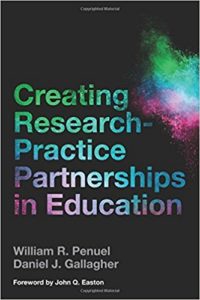 Creating Research-Practice Partnerships in Education is a practical guide that helps to inform both researchers and education professionals on how to form long-term collaborations with one another. The authors draw their ideas directly from their own academic and professional experiences in research partnerships. Penuel and Gallagher have been collaborating through research-practice partnerships (RPPs) for more than a decade, and their expertise is articulated into nine chapters that addresses both broad principles and detailed insights into RPPs. The book begins by introducing readers to the realm of RPPs and the importance of such partnerships for developing strategies in the field of education research. The remainder of the book explore various tools and practices in seeking out, establishing, designing, and sustaining RPPs. Using a combination of scholastic resources and knowledge accumulated through years of practical experience, Penuel and Gallagher have created a highly detailed, yet user-friendly guide on collaborative partnerships in Education.
Creating Research-Practice Partnerships in Education is a practical guide that helps to inform both researchers and education professionals on how to form long-term collaborations with one another. The authors draw their ideas directly from their own academic and professional experiences in research partnerships. Penuel and Gallagher have been collaborating through research-practice partnerships (RPPs) for more than a decade, and their expertise is articulated into nine chapters that addresses both broad principles and detailed insights into RPPs. The book begins by introducing readers to the realm of RPPs and the importance of such partnerships for developing strategies in the field of education research. The remainder of the book explore various tools and practices in seeking out, establishing, designing, and sustaining RPPs. Using a combination of scholastic resources and knowledge accumulated through years of practical experience, Penuel and Gallagher have created a highly detailed, yet user-friendly guide on collaborative partnerships in Education.
Inclusive literacy teaching: differentiating approaches in multilingual elementary classrooms, by Lori Helman
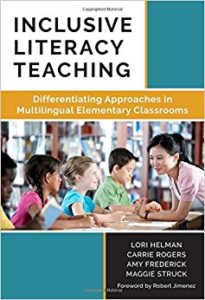 Inclusive Literacy Teaching: Differentiating Approaches in Multilingual Elementary Classrooms combines the study of linguistics and education into a comprehensive guide for teachers. The goal of the book is to provide current and future teachers with key principles and ideas of literacy development for linguistically diverse students. Dr. Lori Helman, an associate professor at the University of Minnesota’s Department of Curriculum and Instruction, presents compelling insights into teaching and education within multilingual environments. The book is divided into seven chapters. The first chapter provides an overview, or “big picture” of linguistics and learning edcation, followed by six detailed chapters that addresses various topics on teaching and learning within a diverse linguistic setting. The ideas articulated in the book draws from an in-depth study of six multilingual students from the first grade through to the sixth grade. The obstacles, successes, and journeys of these students are used to inform the principles presented by the author.
Inclusive Literacy Teaching: Differentiating Approaches in Multilingual Elementary Classrooms combines the study of linguistics and education into a comprehensive guide for teachers. The goal of the book is to provide current and future teachers with key principles and ideas of literacy development for linguistically diverse students. Dr. Lori Helman, an associate professor at the University of Minnesota’s Department of Curriculum and Instruction, presents compelling insights into teaching and education within multilingual environments. The book is divided into seven chapters. The first chapter provides an overview, or “big picture” of linguistics and learning edcation, followed by six detailed chapters that addresses various topics on teaching and learning within a diverse linguistic setting. The ideas articulated in the book draws from an in-depth study of six multilingual students from the first grade through to the sixth grade. The obstacles, successes, and journeys of these students are used to inform the principles presented by the author.
After the “At-Risk” label: Reorienting educational policy and practice, by Keffrelyn D. Brown
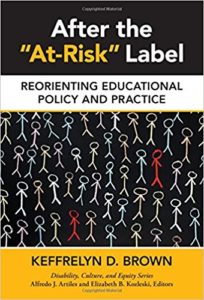 Dr. Keffrelyn D. Brown’s After the “At-Risk” Label: Reorienting Educational Policy and Practice examines the problematic implications and consequences of risk labelling. Dr. Brown explores how teachers and educational leaders see risk in relations to student academic achievement, and argues that sociocultural knowledge regarding risk directly informs educational practices and policies. The unspoken, yet embedded knowledge of risk carries various types of stigma and connotations, and can have a profound influence on how educators approach “at-risk” students. The book is divided into six chapters, each addressing a specific topic on the stigmas of risk within an educational environment. The first three chapters introduces the problematic category of “at-risk” and the historical and political implication of such labels. The following three chapters examines the consequences of “at-risk” labelling through various case studies. The goal of the book is to inform teachers and educational leaders to critically approach and examine the idea of “at-risk” students and dismantle the stigmas surrounding it.
Dr. Keffrelyn D. Brown’s After the “At-Risk” Label: Reorienting Educational Policy and Practice examines the problematic implications and consequences of risk labelling. Dr. Brown explores how teachers and educational leaders see risk in relations to student academic achievement, and argues that sociocultural knowledge regarding risk directly informs educational practices and policies. The unspoken, yet embedded knowledge of risk carries various types of stigma and connotations, and can have a profound influence on how educators approach “at-risk” students. The book is divided into six chapters, each addressing a specific topic on the stigmas of risk within an educational environment. The first three chapters introduces the problematic category of “at-risk” and the historical and political implication of such labels. The following three chapters examines the consequences of “at-risk” labelling through various case studies. The goal of the book is to inform teachers and educational leaders to critically approach and examine the idea of “at-risk” students and dismantle the stigmas surrounding it.
Student lives in crisis: Deepening inequality in ties of austerity, by Lorenza Antonucci
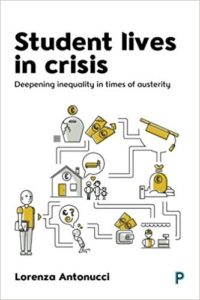 Since the 90s, Europe’s higher education (HE) policies across have encouraged families to send their children to universities as a form of investment. According to Antonucci, the governments’ push towards higher education in the past two decades has been directly responsible for the growth of inequality among Europe’s youths. Her findings show the increasingly high number of youths attending universities have created an oversaturation of overqualified graduates, leading to high rates of unemployment among young professionals. Antonucci argues that policies encouraging higher education are now putting youths into financial crisis due to amounting debt during schooling, which is exacerbated by the lack of employment after graduation. The book presents a series of case studies that looks at students from six different European cities, and explore how higher education have impacted their lives and living conditions. The ideas presented in the book do not seek to criticize higher education, but rather push for revisions of higher education policies in Europe that would better suit the current sociopolitical landscape.
Since the 90s, Europe’s higher education (HE) policies across have encouraged families to send their children to universities as a form of investment. According to Antonucci, the governments’ push towards higher education in the past two decades has been directly responsible for the growth of inequality among Europe’s youths. Her findings show the increasingly high number of youths attending universities have created an oversaturation of overqualified graduates, leading to high rates of unemployment among young professionals. Antonucci argues that policies encouraging higher education are now putting youths into financial crisis due to amounting debt during schooling, which is exacerbated by the lack of employment after graduation. The book presents a series of case studies that looks at students from six different European cities, and explore how higher education have impacted their lives and living conditions. The ideas presented in the book do not seek to criticize higher education, but rather push for revisions of higher education policies in Europe that would better suit the current sociopolitical landscape.
The global educator: Leveraging technology for collaborative learning and teaching, by Julie Lindsay
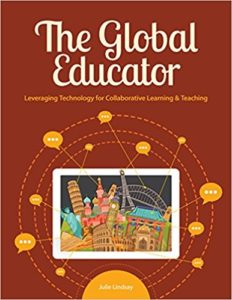 In The global educator: Leveraging technology for collaborative learning and teaching, Julie Lindsay, a global collaboration consultant and “teacherpreneur”, re-imagines teaching and learning within the context of technological growth and global connectivity. The digital age has led to the creation of educational platforms that do not fit the mold of traditional classrooms. Lindsay sees this shift as an opportunity for teachers and educators to foster a new kind of learning that focuses on intercultural understanding and collaboration. She presents the idea of the ‘global educator’ who is not only technologically capable, but is also able to use culturally diverse learning resources and promote connectivity between students. The goal of the book is to inform the development of curriculum that would better promote global learning and collaboration. Separated into four parts, the book examines the importance of global educators in the digital age through the use of case studies, narratives, and the author’s own experiences in global education.
In The global educator: Leveraging technology for collaborative learning and teaching, Julie Lindsay, a global collaboration consultant and “teacherpreneur”, re-imagines teaching and learning within the context of technological growth and global connectivity. The digital age has led to the creation of educational platforms that do not fit the mold of traditional classrooms. Lindsay sees this shift as an opportunity for teachers and educators to foster a new kind of learning that focuses on intercultural understanding and collaboration. She presents the idea of the ‘global educator’ who is not only technologically capable, but is also able to use culturally diverse learning resources and promote connectivity between students. The goal of the book is to inform the development of curriculum that would better promote global learning and collaboration. Separated into four parts, the book examines the importance of global educators in the digital age through the use of case studies, narratives, and the author’s own experiences in global education.
